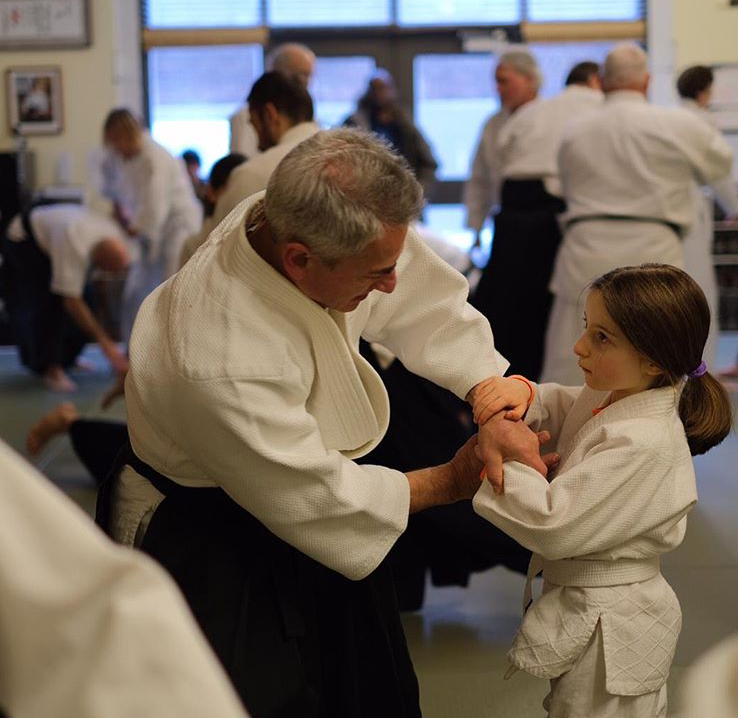武道と私:カナダ人に武道を通じて自制心や礼儀を教える
Aikido Shugyo Dojo 道場長 Gabriel Di Marco

(日本語訳要旨)
日本の武道のひとつ合気道は、90年代に北米で大流行しました。アクションスターのスティーブン・セガールの映画がヒットしたのが大きな理由です。彼は合気道黒帯で日本で修行した武道家です。当時、私の友人があまりにもしつこく誘うので、まあちょっとだけ試してみるかとトロントの道場へ通いはじめました。やってみたらこれが面白くて、すっかりはまってしまいました。以来、日本へも毎年稽古へ行き、30年近く日本の武道と文化を学んでいます。
トロントの私の先生がリタイアするにあたり「合気道修行道場」を引き継ぎました。今もその道場を運営し、カナダ人の子どもや大人を教えています。
「自制心」や「人のせいにするまえに自分を正すことを忘れてはいけない」というのは日本の武道から学べる大切なことのひとつです。カナダ人の若者や子どもたちに合気道を通じて、日本の武道の精神、礼儀も含めた自制心や自己を鍛錬することを伝えていきたいと思いますが、多様なカナダ人にこれを教えるのは一筋縄ではいきません。
稽古に参加する時は少し早めに道場へ到着して、着替え、畳へ上がって心を落ち着けておくこと。そうすると心身の準備が整い、クラスでもよく学べます。しかし、「クラスの始まる5分前までには稽古着に着替えてクラスが始まるのを待つ」を皆に実行させるのさえもたいへんです。
中には「分かりました…。でも、どうして先生より先にこなくてはいけないの?」と質問してくる生徒も。こういう時は、気長に…仲間を大切に思い先生を尊敬する態度だからです、社会に出ても時間を守れる人はプロフェッショナルで信頼できる人間と評価されるのだと話して聞かせます。

道場長は子どものクラスも教えますが、小さい子は道場内でも外でも、まだ礼儀正しくしたり大人のようには行動できないので、これがまたたいへんです。大人相手とは違ったアプローチをしなければなりません。しかし、子どもを教えることは、指導者にとって学ぶことが多くあります。また、大人相手でも子どもに言い聞かせるのと同じようなアプローチでうまくいく場合もあることに気づきます。
私自身、最初のうちはカナダ人の子どもたちに「武道」を教えるなんてできるのか、たいへんだし面倒だとさえ思ったこともありましたが、子どもから教えられたことは本当に沢山あります。子どもと関わる機会がない大人の生徒は「子どもクラス」を教えたり手伝うことでさらに武道の精神が学べると、勧めています。子どものクラスを教えた後は、ただ単に「今日も無事終えて、ほっとした」のではなくて、「充実した気持ち」になれるのは素晴らしい瞬間だと思います。
Teaching courtesy and discipline through the Japanese martial art of Aikido
By Gabriel Di Marco
Aikido was extremely popular in the North America in the 1990’s after the action movies “Above the Law” and “Under Siege,” starring Steven Seagal, came out. Steven Seagal trained in Japan and had a black belt in Aikido. There was a friend of mine who kept asking me to join him in Aikido practice and I finally relented and joined him. I had no intention of staying for very long but as I started my training, I really enjoyed it.
That is how I started Aikido training in Toronto in 1992. When my Sensei, Fran Turner, retired from training and has left me in charge of Aikido Shugyo Dojo located in Toronto’s east end.
One of the things Canadian students learn from training in Aikido or other Japanese martial arts is discipline. Now discipline covers a whole range of items but one of these is self discipline.
This is not something that is usually on your mind and so you become lacking in it. Being aware of your self discipline is your first steps in self discipline becoming the normal. Awareness, especially of self, goes a long way into self development – mentally, physically, spiritually.
When you come to the dojo for training, it’s always best to arrive early so that you have time to get changed and enter the mat and settle your mind before class begins–at least five minutes before Sensei is on the mat. Then you will get the most out of training. This also shows respect for the instructor.
Some students ask, “why do I have to be there five minutes before sensei arrives?” or “why is it so important to get ready early? Don’t I get a credit for just making it to class when I was busy and stressed!”
I would patiently explain “punctuality is a sign of professionalism and helps you stand out as a reliable and trustworthy person at work, too!”
As Chief Instructor (dojo-cho) of a dojo, I have the obligation of teaching all the dojo students. Some of those students will probably be children.
Children require a different approach than when teaching adults, since they do not always understand proper behavior based on the etiquette in the Japanese martial art, either inside or outside of the dojo.
This can be challenging for some instructors. It requires a lot more patience and different methods of teaching than when dealing with adults – although some adults continue to behave like children in adulthood and the same way of getting your point across still works!!
When I first started teaching the children’s class, I was reluctant and unsure what to expect. It was daunting for sure, but I gave it a try anyway. As with all new endeavours, you will make mistakes (hopefully small ones) but if you learn from those mistakes and keep going, you will find that you become a better instructor for the children’s classes and the adult classes.
There is a huge turn-over rate for children as some lose interest after a while or some are there because their parents wanted them to try it out. What ever the reason, most of the children do not pursue Aikido training into adulthood.
The difficult time comes in their late teens/early twenties as it is a busy time in their lives with much going on with school and other activities. Makes you wonder if it is worth the time and effort to teach Aikido to children.
Well, for those few, those precious few who have the drive and want to make the effort to continue into adulthood, then yes, it is worth the effort as they have the potential to explore the art deeper than those of us who started later in life. They have the potential to become true masters of the art.
For those of you who do not have children or do not need to deal with children in your life, I find that you are missing something in your training. Even helping with the children’s classes as an assistant or having interaction outside the dojo (Big Brother/Sister) will do wonders for your spirit.
Even now, I sometimes have that hesitant feeling about teaching the children’s class, but I do it anyway and at the end of class I feel…. not relieved but more fulfilled by making the effort.
https://shugyo.com/

